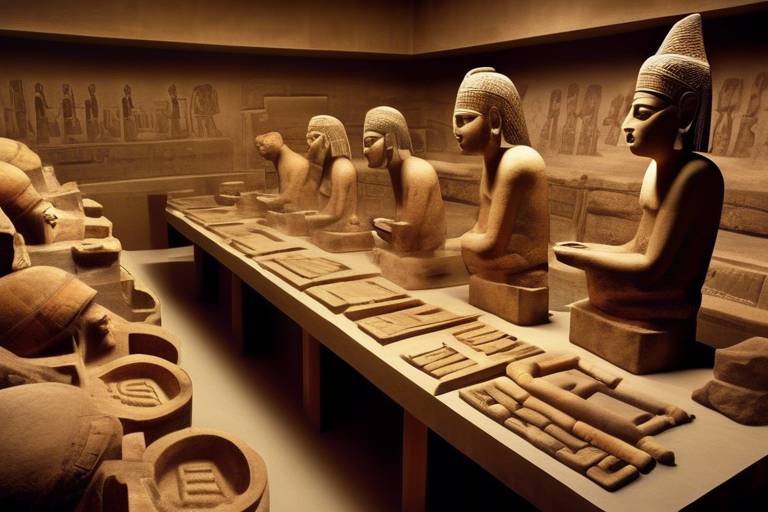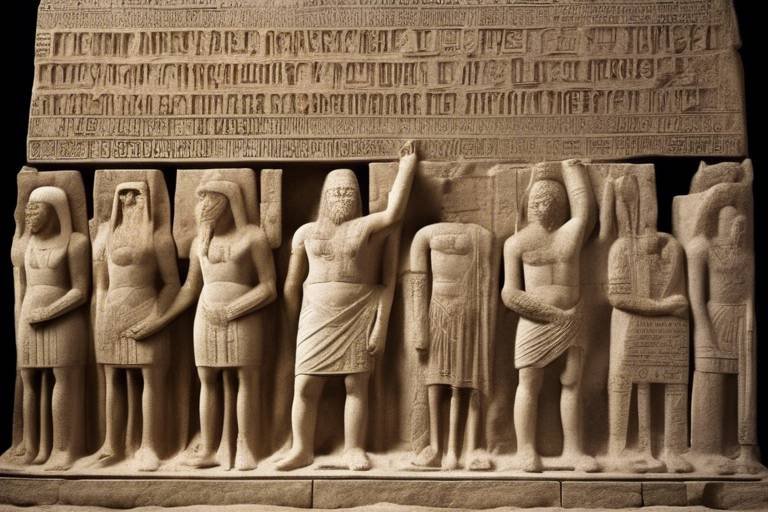The Role of Nonprofit Organizations in Cultural Heritage Education
Nonprofit organizations play a crucial role in the realm of cultural heritage education by actively engaging in various initiatives aimed at preserving, promoting, and celebrating diverse cultural traditions. These organizations serve as pillars of support for safeguarding invaluable heritage assets and ensuring their transmission to future generations. Through a multifaceted approach encompassing preservation efforts, community engagement, education, advocacy, digital innovation, collaborative partnerships, social impact projects, and alignment with Sustainable Development Goals, nonprofit organizations significantly contribute to the enrichment of cultural heritage education worldwide.

Preservation Efforts
Nonprofit organizations play a vital role in preserving and promoting cultural heritage through educational initiatives. This article explores how these organizations contribute to raising awareness, providing resources, and fostering appreciation for diverse cultural heritage around the world.
Preservation efforts by nonprofit organizations are crucial in safeguarding cultural heritage for future generations. These organizations engage in conservation projects, restoration initiatives, and advocacy for heritage protection laws. By actively participating in the preservation of cultural heritage sites, artifacts, and traditions, they ensure the longevity and integrity of these valuable assets.

Community Engagement
Community engagement is a cornerstone of nonprofit organizations' efforts in cultural heritage education. These organizations play a crucial role in fostering understanding and respect for diverse cultural traditions within local communities. By organizing cultural events, workshops, and educational programs, they create opportunities for individuals to actively participate in dialogue and learning experiences.
Through these initiatives, nonprofit organizations aim to bridge cultural divides and promote inclusivity. By bringing people together to celebrate and learn about different cultural heritage aspects, they contribute to building stronger and more cohesive communities. These engagement activities not only educate individuals about cultural diversity but also create spaces for mutual appreciation and collaboration.
Furthermore, community engagement initiatives often involve partnerships with local organizations, schools, and cultural institutions. By collaborating with various stakeholders, nonprofit organizations can maximize their impact and reach a broader audience. These partnerships enable the sharing of resources, expertise, and perspectives, ultimately enriching the cultural heritage education experience for all involved.
In essence, community engagement efforts by nonprofit organizations serve as catalysts for promoting cultural understanding, respect, and unity. By fostering a sense of belonging and shared heritage, these initiatives contribute to the preservation and appreciation of cultural diversity within society.

Education and Outreach
Nonprofit organizations play a vital role in preserving and promoting cultural heritage through educational initiatives. This article explores how these organizations contribute to raising awareness, providing resources, and fostering appreciation for diverse cultural heritage around the world.
Nonprofit organizations play a crucial role in enhancing cultural heritage education through various initiatives. They develop educational resources, curriculum materials, and online platforms to promote a deeper understanding and appreciation of cultural heritage. By creating engaging outreach programs, they aim to reach a broader audience and highlight the significance of preserving cultural traditions.
Moreover, these organizations collaborate with schools, museums, and public spaces to integrate cultural heritage education into formal and informal learning environments. By incorporating interactive learning tools and immersive experiences, they make cultural heritage more accessible and engaging for learners of all ages.
One effective method used by nonprofit organizations is the creation of virtual tours and online exhibitions that allow individuals to explore cultural heritage sites from anywhere in the world. These digital innovations not only provide a unique learning experience but also help in preserving and promoting cultural heritage on a global scale.
Furthermore, nonprofit organizations organize workshops, seminars, and cultural events to facilitate dialogue and interaction among diverse communities. By fostering an environment of inclusivity and mutual respect, they promote cultural exchange and understanding, ultimately contributing to a more harmonious society.
In alignment with educational goals, these organizations emphasize the importance of cultural diversity and heritage preservation. By instilling a sense of pride and responsibility towards cultural heritage, they empower individuals to become advocates for the protection and promotion of their own heritage and that of others.
Overall, nonprofit organizations play a pivotal role in educating the public about the value of cultural heritage and fostering a sense of shared responsibility towards its preservation for future generations.

Advocacy and Policy Influence
Nonprofit organizations play a vital role in preserving and promoting cultural heritage through educational initiatives. This article explores how these organizations contribute to raising awareness, providing resources, and fostering appreciation for diverse cultural heritage around the world.
Nonprofit organizations advocate for policies that support the preservation and promotion of cultural heritage at local, national, and international levels. By influencing decision-makers and stakeholders, they work to ensure the protection of cultural heritage for future generations.

Digital Innovation
Nonprofit organizations in the realm of cultural heritage education are embracing digital innovation to revolutionize the way people interact with and learn about diverse cultural traditions. Through the utilization of cutting-edge technologies, these organizations are breaking barriers and bringing cultural heritage to a global audience like never before.
One of the key digital innovations employed by nonprofits is the creation of virtual tours that allow individuals to explore historical sites and artifacts from the comfort of their own homes. These immersive experiences provide a unique opportunity for people around the world to engage with cultural heritage in a way that was previously unimaginable.
Furthermore, online exhibitions curated by nonprofit organizations bring together collections of cultural artifacts and artworks, offering a glimpse into different traditions and histories. These digital showcases not only educate but also inspire a sense of wonder and appreciation for the richness of global cultural heritage.
Interactive learning tools developed by nonprofits serve as engaging resources for individuals of all ages to deepen their understanding of cultural heritage. From quizzes and games to multimedia presentations, these tools make learning about diverse traditions interactive and fun, fostering a sense of curiosity and exploration.
By leveraging digital platforms and technologies, nonprofit organizations are bridging geographical divides and connecting people from various backgrounds through the universal language of culture. Through digital innovation, the preservation and promotion of cultural heritage are entering a new era of accessibility and inclusivity.

Collaborative Partnerships
Collaborative partnerships are essential for nonprofit organizations working in cultural heritage education and preservation. By joining forces with government agencies, academic institutions, and other stakeholders, these organizations can pool resources and expertise to achieve common goals. Through collaborative partnerships, nonprofit organizations can enhance the impact of their initiatives and ensure a more coordinated approach to cultural heritage preservation and education.

Social Impact and Empowerment
Nonprofit organizations play a vital role in preserving and promoting cultural heritage through educational initiatives. This article explores how these organizations contribute to raising awareness, providing resources, and fostering appreciation for diverse cultural heritage around the world.
Nonprofit organizations empower marginalized communities by highlighting their cultural heritage and providing platforms for expression and celebration. Through social impact projects, they promote inclusivity and diversity in cultural heritage education initiatives.

Sustainable Development Goals
Nonprofit organizations align their cultural heritage education initiatives with the United Nations' Sustainable Development Goals, focusing on goals related to education, cultural diversity, and sustainable cities. By integrating these goals, they contribute to a more sustainable and inclusive society.
Frequently Asked Questions
- What is the role of nonprofit organizations in cultural heritage education?
Nonprofit organizations play a crucial role in preserving and promoting cultural heritage through various educational initiatives such as preservation efforts, community engagement, education and outreach, advocacy, digital innovation, collaborative partnerships, social impact, and alignment with Sustainable Development Goals.
- How do nonprofit organizations contribute to preserving cultural heritage?
Nonprofit organizations engage in preservation efforts by conducting conservation projects, restoration initiatives, advocating for heritage protection laws, and leveraging digital technologies to make cultural heritage accessible globally. They also work on community engagement, education, and outreach to raise awareness and foster appreciation for diverse cultural traditions.
- Why is community engagement important in cultural heritage education?
Community engagement is vital in cultural heritage education as it promotes understanding, respect, and active participation in different cultural traditions. By organizing cultural events, workshops, and educational programs, nonprofit organizations create platforms for dialogue and inclusivity within local communities, enriching the overall cultural experience.



















